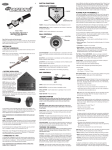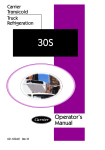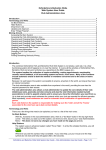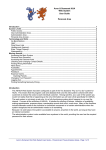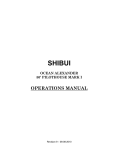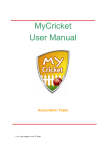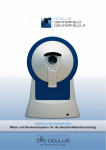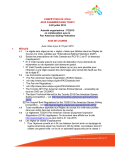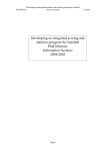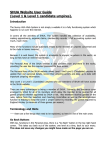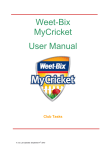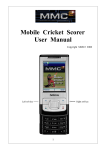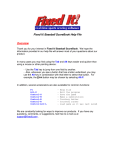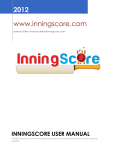Download WALNUT CREEK LITTLE LEAGUE UMPIRE MANUAL
Transcript
WALNUT CREEK LITTLE LEAGUE UMPIRE MANUAL Chief Umpire - Brian N. Chase Ph: 925-368-3058 E-mail: [email protected] Revised 1/16/2010 Walnut Creek Little League Umpires Umpires are a vital part of the Little League experience. Accordingly, in 2010, we will continue our tradition of offering our umpire program to train you in the art of umpiring. The Walnut Creek Little League will provide an opportunity for adults and youth of our community to be involved as Volunteer or Youth Umpires. The goal of the Umpire Program is to build a core group of trained adult and youth (12-17) umpires. The benefits of our umpire program are many: • • • • • Enhances the Little League experience by providing trained umpires for all games The Youth Umpire program keeps older kids involved in baseball Youth Umpires tend to stay involved later on as adults Introduces children and adults to a skill they can enjoy developing over time Provides a platform for adults to volunteer and become involved in their children’s Little League experience Umpiring is time-consuming – not only games, but also to complete the training needed to meet our league’s standards. However, beyond the minimal requirements, the timecommitment you make is controlled by your goals, which can range from a short-term involvement solely to satisfy the league’s volunteer requirement, to a long-term and in depth commitment for those interested in developing advanced umpire skills and becoming involved in post-season, regional, national and even international events. All Youth and Volunteer Umpires will be fully supported by WCLL to ensure their involvement is a positive experience. Whether there is the need for rules discussion or interpretation, feedback and evaluation, reviewing game situations, or dealing with coaches and parents, umpires are supported in several ways: • • • Umpire in Chief , who reports into the WCLL Board of Directors WCLL Board of Directors Coaches and Managers of the league who report to the league president In order to foster a feeling of mutual respect for each other and for the game WCLL has these expectations of umpires: • • • • • • • Promptness for games Professionalism in appearance and manner Rule knowledge Consistency in game management Flexible relative to player level (e.g. 9-10 year olds) Courteous and helpful to players Aware of safety issues Page 2 of 27 INTRODUCTION This manual introduces many common situations that you will experience as an umpire. Some will occur each game; others will happen just once or twice a season. The key to success is to know what the likely plays are for each game situation and anticipate how to react. This manual will help you position yourself on the field, know in advance what each umpire's responsibilities are, and allow you to develop a sense of self-confidence that is a primary requirement of an effective umpire. Umpires are required in baseball; it's not a game without us. In fact the very first Little League Rule, Rule 1.01, states: “Little League Baseball is a game between two teams of nine players each, under the direction of a manager and not more than two coaches, played on a regulation Little League field in accordance with these rules, under the jurisdiction of one or more umpires.” [emphasis added]. So be proud, take it seriously, have fun and enjoy the best view in the ball park! The first three sections of the manual interpret and provide examples of Little League Rules. It will address common situations and how the rules apply. Of course, nothing substitutes for reading and knowing the Rule Book. The fourth section deals with communication and signals, both to the players and fans, and to your partner. When you're part of a two-person umpiring team there's a lot of ground to cover. Both umpires, the home plate umpire and the base umpire have different roles and responsibilities. By working as a team, you can watch all the plays on the field, and not miss a play. How you move, position yourself, and make calls is called “mechanics.” Sections V and VI discuss mechanics, which addresses positioning at the start of the play, and how to adjust to situations that may occur when the ball is put in play. Page 3 of 27 TEN COMMANDMENTS OF UMPIRING 1. Do not call plays too quickly: Read - Pause - React Read the play. Pause to judge the action, then react and make the call. 2. Do not lose your temper Be quick to think, slow to anger. A decision made in anger is never sound. 3. Be courteous, impartial, and firm Let players or managers speak, but don't allow yourself to be pushed around. 4. Do not even up If you miss a call, continue trying to do your best. Do not make a call in favor of the other team to make up for the one you missed. 5. Get help if necessary Get the call right; if you are unsure ask your partner for help. 6. Hustle into position Don't race the players, but get an angle on the play. Look sharp. 7. Work as a team Cooperate, communicate with and never criticize your partner. 8. Dress the part Dress appropriately, look sharp, have the right equipment. 9. Be confident in yourself Remember that confidence comes from knowing the rules and being in correct position for each play. 10. Learn something every game Read the Rule Book after the game to be clear about any unusual play that may have occurred. Page 4 of 27 TOP 10 ADVICE LIST FOR NEW BLUES 1. Always watch the BALL, and you will likely not miss an important play. 2. Never SEARCH for rules violations, as they will usually become obvious, and don't attempt to call an obscure violation unless you completely understand the rule. 3. Don't let players’, coaches’ or fans’ comments bother you. Parents, and coaches will usually say things like “that looked close” and the like, but they are not meant to undermine your authority. Save your authority for prevention of direct, mean spirited, or repeatedly disruptive personal attacks. 4. Read the Rule Book regularly. Rereading it will cause you to see things you missed the first time. Anything that doesn't sound right probably means you don't have the right understanding of the rule. Ask someone with experience. 5. Never hover around a particular dugout, or mingle too closely with players and spectators, as this will cause problems. You don't want it to look like you favor one team or the other. 6. ALWAYS back up your partner, and NEVER make him look like a fool. If you really disagree with a rules call (not a judgment call), take him aside if time permits, and let him know what you think. Let HIM decide if he wants to make your comment or opinion public knowledge and reverse his call. 7. Let coaches know how you feel about certain types of behavior before the game begins but don't be an anal-retentive jerk. Treat them with courtesy, and they will usually (hopefully) treat you the same way. 8. NEVER get into a shouting match with a spectator.v Go to the offender's team manager, and politely ask him to control his parent(s) or HE (the manager) will be removed from the game. You have no authority over spectators. 9. Always make calls with clear, firm decisiveness, and confidence. 10. Never point to first base when saying “Take your base” after a walk. The first base umpire may mistake your gesture as a call for assistance on a check-swing. If he signals “strike,” you’re in trouble. Page 5 of 27 I. THE BASICS Your role as “authority figure” starts the moment you arrive at the field. Therefore, when you arrive: look and act professional. An umpire who takes pride in his appearance also takes pride in his game. Respect is all about perception. If you look sloppy on the field and look like you don't care, you become a target. And you deserve it. Wear your uniform with pride. You have earned it. Looking Professional: • • • • • Uniform shirt - clean and neat Hat - never worn backwards Heather Grey or dark pants - clean and pressed - no shorts, sweats, etc. Black shoes or sneakers Black socks and belt Acting Professional • • • • • • • • • • • • Know the rules. If you make a mistake, go over the rule after the game. Show up on time and be ready to go. Take charge: your authority is assumed, act that way. Just because the manager is 40 and you're 14 means nothing. You are the umpire. You are in charge. Don't be a jerk about it - just act like it's assumed you are. Be pleasant. Be polite. But, be firm. You are well-trained. You know the rules. Be confident out there. Take your time on calls: Pause-read-react. There is nothing to be gained by rushing except trouble. Your calls: Make 'em loud and make 'em proud - everyone wants to hear. Don't hesitate. The best way to avoid confrontations is to be in the correct position to make the right call, and to “sell” close plays with confident verbal and hand signals. Don't show off though - you are not the show. Don't argue. Listen to reason, but be firm. If you are sure you made the right call, say so, and move on with the game. If you are not sure, listen, use your best judgment, make the call, and move on. If a manager asks you to check with your partner, do it, but it's still your call. Be a team out there: support your partner. Don’t change his calls. If you think your partner missed something, when the play is over, call time and go to your partner first away from the players and coaches. Talk it over. Get it right. Then, whoever made the initial call, announce clearly what the call is now. If a manager insists they want to protest, let them. Note it in the book, and move on. (Covered more in later section) Even professionals make mistakes: treat each call as a new one. Don't try to “even things up” if you blow a call. Page 6 of 27 Let's Go To Work OK, so now it's time for your first game. How's this whole thing work? How does a game unfold? What do I do first? What do I expect the managers and players to do? What do I do after the game ? Before the Game 1. Get to the game on time. Show up early (at least 30 minutes). 2. Confer with your partner (if you have one). Get together on signs and signals. Make sure you know who has the plate. If you are supposed to have the bases, but it is 10 minutes before the game, and he isn't here, put on the plate gear. He's late. He gets the bases. 3. Make sure the field is prepared on time. Home Team should line the field. Make sure there are no safety issues - walk around the field. Look for broken fences, broken glass, trash on the field, broken gates, holes in the ground, standing water, and anything else that's unsafe and anything that could trap a ball. Have the managers fix it before you start the game. You want to impress them with your dedication? Help them do the job. 4. Monitor the pre-game warm-ups. Five minutes for the plate conference. So, have your plate conference at 5:25 for a 5:30 game. Move things along. Start on time. 5. The plate conference. Introduce yourself to the managers, and learn their names. It is easier to have a discussion later if you refer to each other by name. The home plate umpire stands behind the plate, and the base umpire out in front. The managers are on either side. The managers should give you their lineups, home team first, so ask for them. Once the home team hands you its lineup, you are in charge of the field and game. Make sure the home team provides a scorekeeper. Give the lineups to the scorekeeper after the plate conference. 6. Go over the ground rules at the plate conference: things like where dead ball territory is, keep gates closed, if there are holes in the fence what will happen if the ball goes in there, etc. 7. Make sure the players are properly equipped and ready to play. Cups, shoes, masks, other gear, and two game balls for the umpire. Ask this question at the plate conference: “Are all your players legally equipped?” That covers everything: male catchers without cups, cracked helmets, dented bats, etc. Page 7 of 27 8. Male players must wear a cup, no exceptions. It is not necessary to ask them for a "cup check" (knock-knock). 9. Make sure catcher's masks have dangling throat protectors. There’s good reason for this: If the catcher looks up, the protector still covers this throat. Make sure catcher's gear fits properly. Don't start the game until it does. 10. Make sure equipment is in good condition and properly worn. If a helmet is cracked, throw it out of the game. Teams can borrow from each other if needed. Dented/damaged bats should be removed. Ensure the bats are of legal size and type and have the BPF (Bat Performance Factor) rating of 1.15. During the Game 1. Help keep the game moving. Hustle the players into position and back to the dugout, including warming up pitchers. Make sure to ask the manager to get his catcher ready as soon as you can if that looks like it's an issue. (1 minute's for field change and pitcher warm-ups) 2. Stay near the plate during warm-ups, but out of the way near the backstop. If the catcher misses a warm-up pitch, hand him the other ball and go get the one at the backstop. This will speed up warm-up pitches tremendously. 3. Keep warm up pitches to no more than 8 for a new pitcher, 5 for a returning one. On the second-last pitch (6th or 4th) tell the catcher, “One and down”. That means, one more warmup, then the catcher should call out “balls in, coming down” not the umpire, and then the next warmup pitch goes to 2b. Remember, only 1 minutes allotted for infield change-over. 4. “Balls in, coming down” is a privilege, not a right. If the catcher misses it or the 2b or SS doesn't cover, tell him to toss it back to the pitcher and get his team ready. 5. Let the catcher position himself first, and then you set up. If they set up way back, ask “you sure you want to be here?” If they move, fine. If not, fine. They’ll lose strikes for their pitcher if they set up too far away, but you are not the coach. Do talk to the coach if it's a real problem, but that’s something the coach is supposed to notice and fix, not you. Don't let the catcher set up where he will surely get hit. 6. Take care of your catchers. The catcher is your new best friend - take care of him. If you see loose catcher's gear, stop the game and get it fixed. If the catcher gets whacked, stall until he can compose himself. Cleaning the plate is always a good time waster. After all, that catcher is the only thing between you and the pitcher whacking you in the shins (or worse) all game long. Page 8 of 27 7. Keep equipment off the field. This means bats, balls, buckets, catcher's gear, etc. If you see it on the field during play, wait until the play finishes. Call time and have the equipment removed. 8. Keep the players in the dugouts when they aren't on the field; and keep the managers in the dugouts. The dugouts are for players, managers, and coaches only; not spectators. 9. There is NO on-deck hitter in Little League at any time. The first batter of the inning can come out to take practice swings at the start of the inning under your supervision, but that's it. Keep the batter far away from the plate while the pitcher is warming up. 10. There is NO batting donut allowed in Little League. If you see one, ask the manager to put it away. If you see it again, ask one more time, and remind him you've already told him to put that thing away. If you see it a third time, you should consider removing the manager – he asked for it. 11. Make sure you and the coaches stay positive role models. Don't allow poor sportsmanship. Don't let them yell out questionable instructions, such as “Run over the catcher the next time he gets in the way!”. 12. Understand that umpires will make mistakes. Don't try to make up for a bad call. Let it go. Call what you see on the next one. After the Game 1. As soon as the game is over, exit the field nearest the winning team’s dugout. Don't hang around and look for trouble. Protests can be taken up to the point when all umpires leave the field. And always leave as a crew. 2. Put the equipment back clean. 3. Report any broken or missing equipment to the Chief Umpire immediately. 4. If there has been an ejection, a protest or other controversy during the game, report it immediately by sending an e-mail tot he Chief Umpire. This is required to be done within 24 hours of the incident, so don't delay. 5. When you get home, or on the drive home, think about the game and where you might improve. You may be surprised at how well you did. Remember, it's what you learn after you think you know it all that really counts. If you stop learning, you'll stop being a good umpire. Page 9 of 27 II. RULES AND INTERPRETATIONS Umpires need to know the rules. You can know all the rules and still not be a good umpire, but you can't be a good umpire if you don't know the rules. All umpires will attend a basic rules clinic. Don't worry if you don't remember them all right away. Professional umpires spend years studying the rules and they still make mistakes. Do your best out there, and use your common sense and judgment. What Do I Do When I Don't Know the Rule ? You will find yourself in a situation where you can't remember the right rule. The first thing to remember is to calm down and think. It helps to think in terms of advantage and disadvantage. In other words, if the rule really is the way I think it is, how could the defense or the offense take unfair advantage of it, or be unfairly disadvantaged? For example, some people think it's a hit batsman and not a strike if the pitch hits a batter in the strike zone. Think for a second: what if this was true? Imagine its bases loaded, 2 outs, 0-2 count, tie score, bottom of the last inning. Why wouldn't a batter just lean into the strike zone and get hit ? If it was a hit batsman, that's what they would do, and that's not baseball. It's not right. So, the rules makers said “A pitch that hits the batter in the strike zone is a strike, and the ball is dead”. It's right there in Rule 2.00 STRIKE (f). Why is the ball dead? Think for a second - what if the count above was 0-0 - if the ball wasn't dead, a batter could deflect a pitch away from the defense, and the runner on 3rd would score the winning run. That's not fair, it's not right, and it's not baseball, so the ball is dead. It is also appropriate to call “time-out” and confer with your partner about a rule. Carry your Rule Book. It is better to consult the Rules and hold up the game long enough to decide a knotty problem than to have a game protested and possibly replayed. But reference to your Rule Book should be a last resort. In the final analysis: Make your best determination of the rule in an expedient fashion and let play continue. Changing versus Correcting a Call Calls can't be changed except in five instances. But an umpire can always CORRECT a call if he does it immediately after the play. It looks bad, but it's better than sticking with the wrong call. Page 10 of 27 “Changing” a call implies the umpire, after a discussion with a manager or other umpire, has altered his decision. “Correcting” a call means he's calls "Out!" and then immediately "Safe!" when he sees the ball pop out of the glove. For example, the umpire quickly signals a catch on a fly ball, and then the outfielder drops it. The instant the ball fell from the glove, he should have yelled "No Catch! No catch!" and signaled safe vigorously. Of course, this dilemma is avoidable by taking a moment to pause before making the call in the first place. There is no rush. And a pause is better than a sheepish correction. The five instances when a call can be changed: 1. 2. 3. 4. 5. two umpires make different calls on the same play; a rule is misinterpreted; a home run is changed to a double and vice versa; a half swing called a ball becomes a strike; and the ball pops free on a tag, and another umpire sees it. Specific Rules This section elaborates rules of Little League League Baseball and is organized by Rule # and type of situation. References to the Little League Rule Book are given, so you will be able to check exact rule book language. 2.00 - Terms and Definitions Fair/Foul When the ball is hit, calling it fair or foul is the first priority. When using two-person umpire teams, the initial call always belongs to the home plate umpire. When a ball is foul, throw both of your hands up and out and call “Foul ball!” Then point to foul territory. Use your right hand to point foul if the ball was foul off the first base line, and use your left hand to point foul if the ball went foul off the third base line. If the ball is fair, say nothing, because anything you say may be mis-interpreted by a player. Point to fair territory and extend your left arm/hand towards the pitchers mound. Fair and foul is judged by the position of the ball, not the player. If a player stands in fair territory and touches a ball in foul territory, the ball is foul. Page 11 of 27 The best place for the plate umpire to make the call is straddling the first or third base line. If the ball is hit in the infield, the plate umpire can position on the first or third base line extended. This is the imaginary line that extends the base line through home plate and into foul territory. So when you stand on the extended base line you're standing behind home plate. The first and third base foul lines are in fair territory. If a ball hits on a foul line, the ball is fair. Don't rush the call if the ball is rolling in foul territory, but hasn't yet passed first or third base and hasn't been touched by a fielder. Baseball fields are often uneven. If an untouched ball in foul territory hits a bump in the ground and rolls into fair territory between home plate and first or third base, it's a fair ball. Similarly, if the ball starts in fair territory and rolls untouched into foul territory before passing first or third base, it's a foul ball. Any ball that bounces past or over first or third base in fair territory is fair, as is any fly ball past first or third base that initially lands in fair territory. A ball that hits first, second or third base and then deflects into foul territory is a fair ball. Home plate is in fair territory. A ball that bounces off of home plate is no different than a ball that bounces off of the ground around home plate. If a ball is bunted and comes to rest on home plate, it is a fair ball. The pitcher's rubber has no special status; if a ball hits off of the rubber and bounces into foul territory before passing a base or being touched by a fielder it is a foul ball. Foul Tips In the event of a foul tip (the ball hits off the bat and goes "sharp and direct" into the catcher's mitt), the ball is live and it is always a strike. Signal foul tip by running your right hand over the back of your left, and then signal the strike. Don't say anything other than "Strike!" (The moment you say "Foul anything" the play is killed.) If the ball hits off the bat and the catcher misses it, it is a foul, not a foul tip: Throw up your hands and say "Foul ball!" A foul tip must hit the catcher's mitt first, and be caught before touching the ground. If the ball hits any other part of the catcher’s equipment first, it is a foul ball, even if caught. If the ball hits off of the catcher's mitt, bounces off the catcher, and is caught before it hits the ground, it is a foul tip. If it falls inside the catcher's chest protector, it is a foul ball. Any batted ball that bounces off of the home plate umpire is a foul ball. There are no guidelines for judging a foul tip other than the ball goes "sharp and direct" into the catcher's mitt. If the ball pops into the air and is caught before it hits the ground, the batter is out. Remember: never say "Foul tip." Page 12 of 27 Catch/No Catch A legal catch is a ball that is caught on the fly in the hand or glove and held by the fielder until released voluntarily. It's also a legal catch if the ball bounces off of one defensive player and is caught by another without touching the ground, or any object, offensive player or umpire. A fielder may not use a cap or uniform pocket to make a legal catch, although a ball trapped under an arm becomes a catch if the fielder is able to hold the ball in hand or glove before it falls to the ground. A fielder must maintain control of the ball until the momentum of the catch is completed. If a player gloves a fly ball, hits the ground, and does two somersaults, but the ball falls out of the glove involuntarily, it is not a catch. If a caught ball is dropped when the fielder is in the act of throwing it, the catch stands. Judgment is required: you need to determine if the fielder meant to release the ball, and if so, a catch was made. LL Rule 2.00. If a fielder tries to catch a fair ball and it bounces off the fielder and over the outfield fence in fair territory it is a home run. LL Rule 6.09(g) If the fielder tries to make a catch near an out-of-play area (marked by line, rope, or fence), the catch must be completed and the ball in the fielder's control before the fielder steps out-of-play. A juggled ball is not a catch until the fielder holds the ball. After the catch is made, momentum may subsequently carry the fielder out-of-play, but the ball is live unless the fielder falls down. If the fielder falls in out-of-play territory, the ball is dead and runners advance one base. LL Rule 5.10(f). If the ball is bobbled in the act of catching it, base runners only need to tag up at the time the ball is touched for the first time. LL Rule 7.08(d). Out/Safe The batter is called out when: 1. A third strike is caught or not caught by the catcher. In Little League, the batter may not try to run to first base on a dropped third strike. LL Rule 6.05(b) 2. The ball is bunted foul on the third strike. LL Rule 6.05(c) 3. The batter is touched by the ball on a third strike. This occurs if the ball hits the batter in the strike zone, or the batter is hit by the ball while swinging at it. The hands are not part of the bat. If the batter swings at a pitch and the ball hits the batter's hands, the ball is dead and the pitch is ruled a strike. (See the discussion on "Calling Balls and Strikes" in Section V.) LL Rule 6.05(e) Page 13 of 27 4. A fair or foul fly ball is legally caught. (See the preceding discussion "Catch/No Catch") LL Rule 6.05(a) 5. The Infield Fly rule is called. (See the discussion on infield flies later in this section) LL Rule 6.05(d) 6. An infielder intentionally drops a fair fly ball or line drive with first, first and second, first and third, or first, second and third bases occupied and less than two out. The ball is dead and runners return. (Fielders intending to drop the ball usually look around the field before intentionally dropping the ball.) In this situation the batter-runner is not out if the ball falls to the ground untouched, unless an Infield Fly was called. LL Rule 6.05(k) 7. First base is tagged or the batter-runner is tagged before the batter-runner reaches first base. LL Rule 6.05(I) 8. The batter hits a ball, fair or foul, while the batter's foot is entirely outside of the batter's box. This may happen when the batter squares around to bunt. If the batter's foot is outside the box and the batter swings and misses the ball, it is a strike. In order for this rule to apply, the batter must hit the ball and the batter's foot must be completely over the line. LL Rule 6.06(a) 9. The batter steps from one batter's box to the other while the pitcher is ready to pitch. (If the pitcher is not on the pitcher's rubber, the batter is free to move from one side of the batter's box to the other.) LL Rule 6.06(b) In a variety of situations the batter is called out for interference, as discussed below in "Offensive Interference." A runner is called out when: 1. The runner tries to avoid being tagged by running more than three feet outside of a line between the runner's position and the base. The line is between the runner's position and the base where the tag play would occur. You can estimate three feet with the fielder's outstretched arms. This rule only applies when the runner is trying to avoid being tagged-if no play is being made on the runner, the runner may choose any path to the base. LL Rule 7.08(a)(1) Example: On a hit to the outfield the batter-runner rounds first base widely and ends up near the outfield grass between first and second. Before the batter-runner reaches second base the ball is thrown to the second baseman. If the batter-runner continues to try to reach second base, the three foot rule is in effect because the second baseman has the ball and is trying for a tag play. The straight line is from the batter-runner's current position and the base where the tag play will be made. On the other hand, if the batter-runner retreats to first base Page 14 of 27 the three foot rule is not in effect because there is no tag play in effect at first (the ball is still at second base). The batter-runner's initial position on the outfield side of the straight line between first and second does not matter. 2. The runner does not slide or try to get around a fielder who has the ball and is waiting to make a tag. This is sometimes erroneously interpreted as a "must slide" rule; 3. The runner slides head-first while advancing. This is also a special Little League safety rule, and is discussed in later. 4. The runner is called out for interference. (See the "Offensive Interference" discussion later in this section.) 5. The runner is tagged with a live ball while off the base. If the base is dislodged, the runner is safe if in your judgment the runner is either touching the dislodged base, or the spot where the base was originally anchored. LL Rule 7.08(c). 6. LL Rule 7.08(c) and (j) are the rules that protect the batter-runner when overrunning first base. The overrun can occur on a hit, a base on balls, or a hit batsman. No out is called if the runner returns immediately to first base. However, if the runner attempts to go towards second, then the protection ends. Sometimes the defensive team will throw the ball to the first baseman, who tries to tag the runner when returning to first base. If the runner has not made an earlier move toward second, but tries to evade the tag, call the runner safe unless the runner takes off for second base. 7. After a fair or foul fly ball is caught the runner fails to retouch the base before the base or the runner is tagged with the ball. Runners can advance after tagging up if a foul ball is legally caught. If the ball is bobbled but ultimately caught, runners can leave as soon as the ball is touched for the first time. LL Rule 7.08(d). 8. The runner fails to reach the next base on a force play before the base or the runner is tagged with the ball. LL Rule 7.08(e). 9. The runner is touched by a batted ball before it has been touched by all infielders who have a play on the ball; Note: a runner is not out if he unintentionally touches a ball after it passes through or is touched by an infielder immediately in front of the runner provided no other infielder had a play on the ball. Page 15 of 27 10. The runner passes a preceding runner before the preceding runner is out. For example, with a runner on first the batter-runner hits a fly to the outfield. The runner on first holds up, and the batter-runner runs past. The batter-runner is out whether or not the ball is caught. LL Rule 7.08(h) If a trailing runner passes a preceding runner after a home run is hit, the out occurs as soon as a runner passes a preceding runner. If there are two out, this creates a time play situation. For example, if there are runners on first and third with two outs and the batter hits a home run, no runs score if the batter-runner passes R1 before the R3 touches home plate. See the discussion "Scoring Runs" later in this section. 11. The runner misses home plate and does not immediately try to touch the plate, and the catcher holds the ball while standing on the plate and appeals to the umpire for a decision. If the runner attempts to touch home plate, the runner is only out if tagged before the runner touches the plate. LL Rule 7.08(k). As in any appeal play, if the defense does not appeal to the umpire, the umpire says nothing to indicate that the runner missed the plate. 12. A runner may also be called out for interfering with the defensive team's ability to complete a play. (See the next section, "Offensive Interference.") Remember: The offense interferes, the defense obstructs. Interference - Rule 2.00 and 7.09 The umpire must judge that someone on the offense “interferes with, obstructs, impedes, hinders or confuses” a defensive player who is trying to make a play on the ball. Some interference calls are easy, such as a runner being struck by a batted ball, or a runner colliding with a fielder trying to field a batted ball. The troublesome ones are when the umpire must judge the intent of the runner, such as: 1. A runner intentionally makes contact with a thrown ball. 2. A runner fails to avoid a fielder who is attempting to field a batted ball. (Intent is not required). LL Rule 7.08(b). 3. A runner makes contact with or gets in the way of a fielder trying to field a thrown ball. INTENT is required here. If a runner just runs into a fielder while that fielder is waiting for a throw, it's not interference unless the umpire judges the runner intentionally ran into him. Page 16 of 27 4. A runner doesn't contact a fielder fielding a batted ball, but causes him to miss it by some other action. Contact is not needed for interference. So if a runner: yells at a fielder as he runs behind him; waves his arms at the fielder; runs at the fielder and stops at the last second, stops in front of the fielder and jumps over the ball, etc., AND the umpire judges that this act caused the fielder to miss the batted ball, it's interference. 5. A base coach or someone from the bench gets in the way or yells "DROP IT". The rule says any member of the team at bat, not just the batter or runner, can cause interference. Note: If the umpire declares the batter, batter-runner or a runner out for interference, all other runners shall ordinarily return to the last base that was, in the judgment of the umpire, legally touched at the time of the interference. However, if the interference occurred with the intent to break up a double play, the umpire shall call both the runner and batter-runner out. Batter's Interference - Rule 6.06(c) There are things a batter does (or fails to do) that are interference, and other things he does (or fails to do) that do are not. Note: The batter's box is NOT a safety zone for the batter. However, If he's in the box, he's usually OK in these situations: 1. The ball gets by the catcher and the catcher knocks over the batter trying to get to the ball (no penalty, live ball). 2. The catcher throws the ball back to the pitcher or to a base to retire a base stealer, and the ball hits the batter or his bat (no penalty, live ball UNLESS the batter PURPOSELY moves into the catcher or the path of the ball). 3. The batter swings so hard that he hits the catcher's glove on the follow-through, knocking the ball away from the catcher (dead ball, runners return). However, if the batter had time to get out of the box but stays in and gets in the way, then he's guilty of interference. This usually happens in lower levels when the ball gets by the catcher, a runner tries to score, and the batter stays in the box and affects the play at the plate. If the batter gets in the way of a play while OUT OF THE BOX, he will almost certainly be guilty of interference, even if it's unintentional. Page 17 of 27 Obstruction - Rule 2.00 and 7.06 Like interference, this is a tough call when there is no contact. If a runner has to slow down or stop because of a fielder's action OTHER THAN fielding a batted ball, you have obstruction. Example of obstructions that is not so obvious: 1. A fielder boots the initial play, and then gets in the runner's way as he goes after the ball. No interference here on the runner because the fielder booted the ball. The fielder is only "protected" on the initial play, not a subsequent play after his error. 2. A batter-runner has to slow down on his way to first because the first baseman is standing on the base. This happens a lot in the lower divisions. 3. A fielder stands in the baseline or puts his leg down and blocks the base or plate well before he has the ball. A fielder cannot block the base while he is waiting for the throw to come in. 4. A fielder fakes a tag on a runner when the fielder does not have the ball. Remember that there are two types of obstruction: Type A, where the defense is making a play on the obstructed runner (immediate dead ball, runners advance to the base they would have reached in the umpires’ judgment), and Type B where the runner is obstructed while play is going on elsewhere (play goes to completion, then umpire calls “time” and imposes a penalty to nullify the effect of the obstruction). Appeals (LL 7.10) If a runner misses a base or fails to tag-up, the defensive team may appeal the play. An appeal must be made while the ball is in play. The appeal may occur at the end of a play before "Time" is called, or it may be the first action after the ball is put in play after a call of "Time." The defensive team must either orally appeal to the umpire, or unmistakably show through their actions that an appeal is being made. If "Time" has not been called, the defensive team has three options if they think the runner missed a base. The defensive team may 1) touch the ball to the runner who they believe committed the infraction, or 2) touch the ball to the base they think the runner missed. If the runner left early, they may also touch the ball to the base they believe the runner left. In any of these cases the team should appeal to you for a call. If "Time" was called, the pitcher must hold the ball on the pitching rubber and the plate umpire must put the ball in play. The pitcher then must step off the rubber, and make the appeal with the ball. If the team tries to appeal while "Time" is called, tell them to put the ball in play, and appeal again. Page 18 of 27 The defense loses its right to an appeal if any other play occurs after "Play" has been called. For example, if on an appeal the ball is thrown out of play, the opportunity to appeal is lost. If an appeal is being made at one base, a runner on another base may attempt to advance because the ball is in play. If a runner misses home plate, is not tagged by the catcher, and does not immediately try to touch home plate, the catcher may appeal to the ump for a decision. To do this the catcher needs to stand on home plate with the ball while making the appeal Award of Bases (LL 7.05) Award Each Runner One Base: 1. When a pitched ball goes out of play or goes over or through a field fence or backstop. The ball is dead. LL Rule 7.05(h). 2. When a pitched ball lodges in the catcher's or umpire's equipment. If this occurs on ball four, the batter-runner gets first base, and all other runners advance one base whether or not they are forced. LL Rules 5.09(g); 7.05(I). 3. When a fielder catches a fair or foul fly ball and then falls down out of play. LL Rule 7.04(c). 4. In some cases runners move up one base when they are forced to because the batter is awarded first base. This occurs when: a. b. c. d. The batter receives a base on balls. The batter is hit by a pitch that is not a strike. The catcher or a fielder interferes with the batter. A batted ball hits a runner or umpire in fair territory before the ball has passed infielders who have a play on the ball. LL Rule 7.04(b). Award Each Runner Two Bases: 1. When a fair ball bounces or is deflected out-of-play, or rolls under or through a field fence, or sticks in the fence. (This is usually called a ground-rule double.) LL Rule 7.05(f). 2. When a thrown ball goes out of play. If the throw is the first play by an infielder and all runners have not advanced at least one base at the time of the throw, then the award of bases is from where the runners were standing at the time of the pitch. In all other cases, the award of bases depends on where the runners are Page 19 of 27 standing when the ball is thrown. If the first throw is by an outfielder or the throw occurs after the first play in the infield, the award of bases is from the runner's position at the time of the throw. LL Rule 7.05(g). For example, runner on first. The batter hits a ball that bounces off of home plate and goes high in the air to the third baseman. The third baseman tries to throw the ball to first base, but the throw is high and the ball goes out of play. If BR has not crossed first base at the time of the throw, and R1 has not advanced past second base, then the runners are given two bases from their positions at the time of the pitch: R1 is awarded third base and the batter is placed on second base. However, if the ball is thrown after the batter passed first base and the R1 passed second base, then R1 is awarded home plate and BR is awarded third base. In the same situation, if the ball was hit to the outfield, then the award of bases is from the runners' positions at the time of the throw. In some cases the positioning of one runner will prevent you from awarding the other runners two bases. For example, a high fly hit into the outfield with a runner on first base. R1 goes half-way to second base, and before the throw is made the batter-runner rounds first and pulls up behind R1. The outfielder misses the catch, and hurries the throw back into the infield. In doing so, the throw is wild and goes out of play. If R1 had not passed second base at the time of the throw, R1 is awarded third base, and BR is placed on second. 3. When a fielder deliberately touches a thrown ball with a cap, mask, or any part of the uniform detached from its proper place on the fielder, or deliberately throws a glove at and touches a thrown ball. Runners get two bases from their position at the time of release of the throw. The ball is still live, and runners can advance beyond two bases at their own risk. LL Rule 7.05(d) & 7.05(e) Award Each Runner Three Bases: 1. When a fielder deliberately touches a batted ball with a cap, mask, or any part of the uniform detached from its proper place on the fielder, or deliberately throws a glove at and touches a batted ball. The ball is still live, and runners can advance beyond three bases at their own risk. LL Rule 7.05(b) & 7.05(c). Award Each Runner Home Plate: 1. When, in your judgment, a ball that would have been an over-the-fence home run is deflected by a fielder who throws a glove, cap, or any other part of the uniform. LL Rule 7.05(a). Page 20 of 27 2. When, in your judgment, a ball that would not have been an over-the-fence home run is deflected by a fielder over the fence at a distance no less than 165ft, will be granted a home run. LL Rule 6.09(h). Scoring Runs (LL 4.09) By definition, a run scores when a batter becomes a runner and legally touches all bases in sequence before being put out. With less than two outs, there generally isn't much of a question about whether or not a run scores if first, second and third were properly touched. About the only case occurs when the runner misses home plate and does not immediately try to touch it. In this case the runner can be called out on appeal. When there are two outs things get more interesting. No run scores if the third out is made by any runner prior to reaching the base to which that runner was forced. Examples of force out situations occur when: 1. A batter or runner is called out for interference prior to reaching the base to which the batter or runner is forced. 2. A runner is forced to a base, but misses it on the way to the next base and an appeal is made. 3. In a dead ball situation a runner is called out on appeal for missing the base to which the runner was forced. See the discussion on the next page. If the third out occurs at first, second, or third and is not a force play, a run scores so long as the runner crosses home plate before the third out is made. This type of call is a "time play." A time play requires that you be aware of which event occurs first. If a time play occurs and the out is made on the bases before home plate is touched, the run does not count. As the home plate umpire, try to line yourself up so you can see both plays in a straight line. Remember that time plays never occur in a force out situation. If a successful appeal is made on a runner at a base where no force play exists, runners ahead of the appealed runner score, but the appealed runner and any following runners do not score. Page 21 of 27 Dead ball situations occur on a ground rule double, a home run, or when a fielder throws the ball out of play. Because the ball is dead, the defensive team can't do anything about base running infractions until a new ball is put in play. If the defensive team properly appeals at a base to which the runner was forced (for example, if they appeal that the batter missed first base) then the appeal is a force out and no runs score. If the appeal is made at any other base, then preceding runners score, and the trailing runners do not. LL Rule 7.10(b). The Little League Strike Zone (2.00) "The STRIKE ZONE is that space over home plate which is between the batter's armpits and the top of the knees when the batter assumes a natural stance. The umpire shall determine the strike zone according to the batter's usual stance when that batter swings at a pitch." The strike zone on TV or at a big league game (pictured on the Left) is not the Little League one. The Little League strike zone is higher than the one in the Major Leagues, and it's the pictured on the Right. Page 22 of 27 Infield Fly Rule (LL 2.00) The infield fly rule is in effect when there are runners on first and second, or on first, second and third with less than two outs. The infield fly rule prevents the defense from taking advantage of a runner's need to tag-up after a fly ball. Without the infield fly rule, the defensive team could let an infield fly drop to the ground and then turn a double play at second and third bases. To be an infield fly the ball must be: a. b. Hit in the air in fair territory. Catchable by an infielder using ordinary effort. An infield fly is not called on a line drive or if the batter bunts the ball. When a possible infield fly is in effect, signal your partner by placing your hand over your cap with index finger up. Then, if the ball is hit in the air, watch the flight of the ball and judge where it is going to land. If the ball can be caught by an infielder with ordinary effort point to the sky with your right hand and call "Infield fly." Try to make the call when the ball is at its highest point in the sky. When an infield fly is called, the batter is automatically out whether or not the ball is caught, and all force plays are removed. The ball is live during an infield fly. The runners can advance at their own risk once the ball is touched or hits the ground. Once you call an infield fly you have to stick with the call, so it's important to be right the first time. If the ball is hit near the foul lines, point to the sky and say "Infield fly if fair." If the ball is not caught and lands near the foul lines it may or may not be an infield fly, depending on where it is when first touched by a fielder. For example, if a possible infield fly drops untouched in fair territory and then rolls foul (before passing first or third base), then it is ruled a foul ball. If a possible infield fly drops in foul territory and rolls untouched into fair territory (before passing first or third), then the batter is out. You will need to use judgment to rule on an infield fly if the ball is hit into the short outfield. For example, if a potential infield fly is hit into short left field, and the shortstop drifts out and could easily catch the ball, call infield fly even if the left fielder comes in and calls the shortstop off the ball. The shortstop's position in the outfield does not matter. A runner is not out if standing on a base when hit by an infield fly; if the runner is off the base and is hit then both the runner and batter are out. LL Rule 7.08(f). Page 23 of 27 Batting Out of Order (LL 6.07) This one is ALWAYS fun to try and straighten out. To simplify the rule, you must understand one basic premise: the PROPER batter (the one who should have batted) is the one who is called out. Here's more to try to clear this up: • The ONLY time the proper batter is called out is when the defense appeals after the improper batter completes his time at-bat (getting on base or making an out). • If the defense appeals while the improper batter is batting, the proper batter simply replaces the improper batter, and the proper batter assumes the count. • Any base running advances or put outs while the improper batter is up are upheld. • Any base running advances or put outs when the improper batter puts the ball in play are nullified (so if an improper batter hits into a double play, the defense may not want to say anything !) • If the defense fails to appeal an improper batter before the next pitch or play, the improper batter is now "legalized", and next up is the person following the legalized batter in the order. • The scorekeeper is NOT ALLOWED to bring this situation to the umpire's attention. It is the manager's responsibility to catch a batting out of order situation and to inform the umpire. • The umpire is not allowed to bring this situation to anyone's attention either. That's the manager's job. Illegal Pitches & Illegal Acts (LL 2.00, 8.05) Illegal Pitches There are two kinds of illegal pitches defined in LL Rule 2.00: 1. The pitcher pitches the ball when the pivot foot is not in contact with the rubber. 2. A quick return pitch, in which the ball is pitched before the batter has sufficient time to get ready for the pitch. The penalty for an illegal pitch is a ball. If the batter puts the ball in play and if the batter advances to first base and all base runners advance at least one base without being put Page 24 of 27 out, then the play must stand.. The manager does not have an option to accept the penalty or the play. If an illegal pitch hits the batter, the batter is awarded first base. LL Rule 8.01(d). Illegal Pitches as defined in LL Rule 8.05, only apply with runner(s) on base(s). Illegal Acts on the Ball The pitcher cannot bring the pitching hand in contact with lips or mouth while standing inside the ten foot circle surrounding the pitching rubber. If this occurs, immediately call a ball, and warn the pitcher that repeated violation can cause removal from the game. However, if a pitch is made and the batter reaches first base on a hit, error or hit batsman, and every runner safely advances at least one base, then the play stands. LL Rule 8.02(a)(1). The pitcher also cannot apply any foreign substance to the ball, spit on the ball (or hand or glove) or otherwise deface the ball. Note: A rosin bag may be used and rosin applied to the hand only (not the glove or the ball). LL Rule 8.02(a)(1). Other Illegal Acts The pitcher may not intentionally pitch at the batter. If this occurs, you can either expel the pitcher from the game or warn the pitcher and managers of both sides that another such pitch will cause the pitcher to be ejected from the game. LL Rule 8.02(c). With the bases empty, if the pitcher delays a pitch by more than 20 seconds after receiving the ball, a ball may be called. The purpose of this rule is to avoid unnecessary delays. LL Rule 8.04. Manager's Visits to the Pitcher The manager or coach can only make three visits to any single pitcher during the same inning, and only four visits to the same pitcher during the entire game. Only two visits can be made while the same player is at bat. On the third visit in an inning, or the fourth visit during the game, the pitcher must be replaced. When a new pitcher comes in, the visit count resets. Any visit with any defensive player counts as a visit with the pitcher. LL Rule 8.06. Page 25 of 27 III: SPECIAL LITTLE LEAGUE RULES There are a few rules that are unique to Little League, and do not exist at more advanced levels. Some of those you are likely to encounter are discussed below. Leaving the base early: LL Rule 7.13 A runner may not leave the base until the ball reaches the batter. If a runner leaves early, signal the violation and let the play go on. The penalty for leaving early is assessed after the play ends. This rule takes effect when the pitcher is on the rubber with the ball and the catcher is in the catcher's box ready to receive the ball. This rule is unique to LL, and may cause umpires a lot of headaches. The bottom line: if any base runner leaves a base before the pitch reaches a batter, all runners are guilty. Depending on the subsequent action, runners must return to any unoccupied bases. The Rule Book has a number of examples that are pretty straightforward. Some that are less understood: 1. If the batter is subsequently thrown out on a play, all runners return. For example, a batter hits a double with the bases loaded, but gets gunned down trying for a triple. Since his out left all the bases open, no runs score and all runners must return. If his out was the third out of the inning, no runs score and the inning is over! Expect the offensive manager to be very peeved by this. 2. The runners can only advance to the bases they would have achieved based on the plate umpire's judgment of the base value of the hit, regardless of any subsequent errors. For example, a batter hits a sharp grounder to centerfield with the bases loaded, and the ball goes under the centerfielder's legs all the way to the fence. The umpire may judge the value of the hit was a single. If so, he puts the batter on first, and the other runners on second and third (only 1 run scores). 3. If with the bases loaded the ball doesn't leave the infield, no runs score, even if the batter-runner reaches first base safely. In this event, the runners each advance one base, except that the runner on third base is removed from the field without an out being imposed. This is explained in Example 15 in the Rule Book. 4. If a runner leaves early, he cannot correct his mistake by returning to touch the base. For example, a runner on second leaves early, then sees the ball is flied to right. He tags up and tries for third, and ends up scoring on a wild throw. He must return to second because he left early, regardless of the fact he subsequently tagged it. There is no “fixing” a 7.13 violation. Page 26 of 27 Head-first slide: LL Rule 7.08(a)(4) A runner is automatically out for a head-first slide while advancing. This is not a force play, which can create a time-play situation if another runner is trying to score. That is, no run can score after the head-first slide occurs which results in the third out. If the runner is retreating to a base then a head-first slide is allowed. Thus, a runner who rounds a base may legally dive back into the base he rounded. Must slide or avoid contact: LL Rule 7.08(a)(3) There is no must-slide rule in Little League. The runner has three options when the Fielder has the ball and is waiting to make the tag: slide, attempt to get around the fielder, or go back to the previous base. If the runner does neither and goes in standing up into the fielder, he's out. But if he attempts to get around and successfully avoids the tag without going out of the baseline, he's safe. Remember, the fielder must have the ball and be waiting to make the tag. If the ball is on its way to a base, or the ball and runner get there simultaneously, and there's contact because the runner didn't slide or attempt to get around, this is just a collision. Out of the baseline (7.08a1): The confusion with this rule is the definition of “baseline.” The runner establishes the baseline. It is not necessarily the direct line between the two bases. For example, if the runner takes a wide turn at first into the grass in short right field, and the throw comes back to first, the baseline goes from the runner to first base. If the first baseman tries to tag him, the runner cannot deviate more than three feet to either side of this line. The runner is not out for being out of the baseline unless he's avoiding a tag. If he's running around a fielder who is trying to field a ball, there is no violation. No jewelry: LL Rule 1.11(j): No player may wear watches, rings, pins, jewelry, earrings or other metallic items. The only exception is Medical Alert items. Third strike is always an out. LL Rule 6.05(c): In Little League, a third strike is always an out, whether or not the catcher catches the ball. The batter-runner may not try to reach first base on a dropped third strike. However, in Juniors, a batter-runner may attempt to advance to first base if the ball is not caught by the catcher and first base is unoccupied. Page 27 of 27 WCLL 2010 UMPIRE UNIFORM AND EQUIPMENT As a WCLL umpire, you are expected to come to your games prepared. Part of your preparation is to wear the proper uniform and to use the proper equipment. A. Basic Uniform Standards for all Umpires • ALWAYS WEAR YOUR UMPIRE SHIRT AND HAT with Little League Umpire patch attached to shirt • Wear dark pants preferably navy blue, black, or gray with your shirt • DRESS TO LOOK LIKE AN UMPIRE - you'll get more respect -Tuck in your shirt and wear your hat forward • Guys behind the plate MUST wear a cup B. Other Personal Equipment You Need at Each Game • Rule Book for the Division your are assigned • WCLL Standing Rules • Indicator and Plate brush – have your own for both plate and field assignments • Protective cup, athletic supporter, or compression shorts worn under pants • Pencil and notepad C. Field Equipment for Your Use • Masks, shin guards and chest protectors for the umpires are located at every field • Keep them clean • Put away in equipment box after each game. Don't just throw in the dirt • Notify the Umpire-in-Chief if damaged, wrong size, or missing, especially at the end of the season D. Prepare for the weather • Bring long sleeves, coat, or sweatshirt for evenings and cool days – dark jacket is preferred. • Have plenty of water for hot days • Bring a snack for between games if doing a double header E. Don’t Bring or Wear the Following Prohibited Items • Shorts • Sunglasses • Sandals or open toe shoes • White or gray clothing or hats • Don’t wear a watch or use your cell phone during a game. • Don't have loose change or keys in your pocket Optional Uniforms for Major BB/SB and older Divisions: For those experienced umpires who umpire in the Majors and above, we suggest you consider acquiring your own personal uniform and equipment similar to that used by high school and professional umpires. These items may be made available to you on loan or for purchase at the League’s cost. • • • • • • • • Navy blue short sleeved polo shirt with red and white piping Heather gray pants with wide black belt Black socks Black field or plate shoes (no metal cleats) Black ball bag worn on belt Navy umpire hat with “WCLL” logo Navy blue pullover windbreaker (optional) Personal chest protector, mask, shin guards WCLL Umpires Manual 2010 Revision 1 WCLL 2010 UMPIRE GAME ASSIGNMENT PROCESS Once again for the 2010 Season, WCLL will be using an on-line Internet based Umpire Game Assignment system. The following procedures should be followed for you to obtain an umpire game assignment: Basic information on the WCLL Umpire Website: Address: www.wcllumpires.org Once you have completed your training, your personal information will be entered to the Umpire Website database. This information is maintained in a secure manner, with a limited number of individuals having access to your name, address, and contact information. Each of these individuals has been authorized by the WCLL Board to access this information, and have authorized the league to obtain a Background Check on them related to records of crimes against children. Once setup in the system, you will receive an e-mail from the Administrator telling you your User Name and Password. You must have an e-mail address to use the system. Finding a Game to Work: Once you access the website with your user name and password, you will see menu that will allow you to search for games that you are qualified to umpire. You will only be able to schedule yourself for those Divisions that the Chief Umpire has determined you are qualified to umpire. You can search for available games by date or division. Once you find a game with an open slot, you then select the assignment (plate or field) and the system will fill in your name. NOTE: Youth umpires are not permitted to umpire games without being paired with an adult umpire. Therefore, the website will not permit youth umpires to sign up for games in which another youth umpire has already signed up. You will get a confirming e-mail with e-mail with your assignment information, and the managers of the two teams will also get an e-mail informing them you are one of their umpires for that game. Changing Game Assignments: After you have been assigned to a game and you find out you are not available, you must go back into the website and delete yourself from that game. If is less than 72 hours before the game, you should call the Division Umpire Coordinator and let them know so they can find another umpire. The website will not let you delete an assignment within 48 hours so you must call the Coordinator for those changes. Feedback on a Game: The Umpire Website also has tools to let you give Game Feedback of other comments directly to the Chief Umpire. You will find this on the Menu page. After each game, please complete your comments so that we are aware of any conduct, protest, field or equipment conditions, or other issues. The Umpire Website has a complete User’s Manual that is available on line. WCLL Umpires Manual 2010 Revision 1 50 RULE MYTHS OF LITTLE LEAGUE BASEBALL Each myth is followed by the rules that apply - either to disprove it or show there's nothing in the rule to support it. 1. The hands are considered part of the bat. - 1.10, 6.05(f), 6.08(b) 2. The batter-runner must turn to his right after overrunning first base. - 7.08(c) & (j) 3. If the batter breaks his wrist when swinging, it's a strike. - 2.00 - Strike 4. If a batted ball hits the plate first, it's a foul ball. - 2.00 - Fair Ball & Foul Ball 5. The batter cannot be called out for interference if he is in the batter's box. 6.06(c) 6. On a foul tip, the umpire must announce "Foul," and the ball is dead. - 2.00 Foul Tip 7. The batter may not switch batter's boxes after two strikes. - 6.06(b) 8. The batter who batted out of order is the person declared out. - 6.07(b) 9. The batter may not overrun first base when he gets a base-on-balls. - 7.08(c) 10. A runner is always out if a batter ball hit him. - 7.08(f) 11. If the batter keeps his bat in the strike zone while bunting, it's an automatic strike. - 2.00 - Bunt & Strike 12. The batter is out if a bunted ball hits the ground, bounces back up and hits the bat again. - 6.05(g) 13. The batter is out if his foot touches the plate when he hits the ball. - 6.06(a) 14. The batter-runner is always out if he runs outside the running lane after a bunted ball. - 6.05(j) 15. A runner is out if he high-fives a coach or other players after he hits a homerun over the fence. - 7.09(I) 16. Tie goes to the runner. - 6.05(i), 7.08(e) 17. The runner gets the base he's going to, plus one base on a ball thrown out-of-play. - 7.05(g) 18. In an Infield Fly situation, the umpire must call it anytime the ball is popped up in the infield. - 2.00 Infield Fly 19. Runners may never run the bases in reverse order. - 7.02 20. The runner must always slide when the play is close. - 7.08(a)(3) 21. The runner is always safe when hit by a batted ball while touching a base. 7.08(f) 22. A runner must physically make contact with a fielder making a play to be called out for interference. - 7.09 23. It is a force out and no runs can score when a runner is called out for not tagging up on a fly ball. - 7.10(a) 24. An appeal on a runner who missed a base cannot be a force out. - 7.10(b) 25. A runner is out if he runs out of the baseline to avoid a fielder who is fielding a batted ball. - 7.08(a)(1) 26. Runners may not advance when an infield fly is called. - 2.00 - Infield Fly 27. An umpire interferes if he gets in the way when the catcher goes after a wild pitch/passed ball. - 2.00 Interference, 5.09(b) 28. A pitch that bounces to the plate cannot be hit. - 2.00 - Ball & Strike 29. The batter does not get first base if hit by a pitch after it bounces. - 2.00 - Ball 30. If a fielder holds a fly ball for 2 seconds, it's a catch. - 2.00 - Catch 31. You must tag the base with your foot on a force out or appeal. - 6.05(I) 32. The ball is immediately dead on an illegal pitch. - 7.08(c) 33. If a player's feet are in fair territory when the ball is touched, it is always a fair ball. - 2.00 - Fair Ball & Foul Ball 34. The ball must always be returned to the pitcher before an appeal can be made. 2.00 - Appeal 35. A batter is automatically out if he throws the bat. - 6.05 36. A fielder must make physical contact with a base runner for obstruction to occur. - 2.00 - Obstruction, 7.06 37. The pitcher cannot take signs from his manager or coach. - 8.01, 8.02 38. If a fielder catches a fly ball and then falls over the fence, it is a homerun. - 2.00 Catch, 6.09(h), 7.05 (a) 39. The ball is dead anytime that an umpire is hit by the ball. - 5.09(f) 40. The manager must appeal a bad call to the plate umpire. - 9.02(b) 41. The manager can visit his pitcher once every inning. - 8.06(a) 42. The pitcher cannot wear a white T-shirt under his uniform. - 1.11(a)(3) 43. A fielder cannot fake a catch to decoy a runner into slowing down. - 2.00 Interference & Obstruction 44. A runner is out if he collides with the fielder who is attempting to catch a throw from the outfield. - 7.08(b) 45. If a runner leaves a base early, he cannot score. - 7.13 46. If a runner misses home plate, he can always go back and touch it for the run to count. - 7.10(b) Approved Ruling 2 47. A starter must play six consecutive outs and bat once before a sub can replace him. - 3.03 48. Players on the bench may yell to distract a fielder from catching a pop fly. - 2.00 Interference 49. A fielder can't trick a runner into returning to a previous base by telling him a pitch was fouled off. - 2.00 - Interference & Obstruction 50. The official scorekeeper must inform the umpire when a team is batting out of order. - 6.07 Note Version 1 WALNUT CREEK LITTLE LEAGUE Umpire Scheduling Web Site User’s Guide WALNUT CREEK LITTLE LEAGUE Umpire Scheduling Web Site User’s Guide Robert S Andrews 3695 Oak Creek Court Walnut Creek, CA 94598 Phone 925.945.1926 [email protected] I N T R O D U C T I O N Chapter 1 Introduction Walnut Creek Little League Umpire Scheduling System W elcome to the Walnut Creek Little League Umpire Scheduling Web Site. The purpose of this web site is to assist umpires, coaches, coordinators and administrators in maintaining a complete schedule up umpires for all baseball and softball games. We tried to make this system as easy to use as possible to so that umpires can quickly manage their own work schedules. We have built in features to keep the coaches informed of their upcoming schedule and the umpire assignments. Coordinators will use the system to identify “gaps” in the schedule and work to fill those gaps with yet unscheduled umpires. Our goal is to maintain full two umpire coverage for every game. We hope that this system makes it easier for all umpires, coaches and coordinators to achieve that goal. Roles Your role determines what you can do in this system. Roles are assigned by and can only be changed by a system administrator. If you find that you are responsible for a role that you don’t have access to, contact the system administrator and your role can be updated. The table below shows the roles that exist in the system and the actions available to those roles: Role Permissions View Has access to the system for the purpose of viewing game schedules and umpire assignments. Does not have the ability to view any personal information or change any game assignments. Umpire Has access to the system. Can view all game schedules. Can change personal contact information. Can choose “home” or “bases” game assignments for open games. Can drop a game (please don’t do this too close to game time). Coach Can view team’s game assignments. Is notified each week of upcoming week’s umpire assignments. Can post a game protest. Can post an umpire evaluation. Coordinator Can assign umpires to games. Can view history of games umpired. Administrator Responsible for user IDs and passwords and can assign coaches to teams. Controls the master umpire list. Assigns umpires to the leagues they are qualified to work. Has access to some management reports not available to other users for personal privacy reasons. 1 I N T R O D U C T I O N Finding The Web Site Note: If you are an umpire but not a computer user, you can schedule your games by speaking directly with the umpire coordinators who can load your games into the system. The entire umpire scheduling system operates from a standard WWW browser. You can run this system from any type of computer than is capable of running a browser and that is connected to the Internet. We hope this makes it accessible to everyone. To access the system, simply point your web browser to http://www.wcllumpires.org. If you are successful, you will see a screen like this: The screen gives you a basic introduction to the site and asks you to click the “please click here” link to log in. Every screen in this system will have a similar look to this screen. The heading will be the same, but inside the heading box, the name of the screen will also be shown (e.g., “Schedule a Game”, “Main Menu”, etc.) This will make it easy for you to figure out where you are at any time. At the bottom of the screen are some links to the various hosting sites or technologies that I used to build this website. 2 I N T R O D U C T I O N Logging In When you click the link to log in, the system will first check to see if you are already logged in. If you are, then you will go directly to the main menu. If you are not, then you will have to enter your user name and password into the system. Each user is assigned a login user name by the administrator. You should already know your user name. When the administrator creates your account, your password will be set to the word “password”. When you log in for the first time the system will require you to change your password. The password must be at least six characters long. There are no other restrictions on the password you can choose. After you change your password, you will have to log in again, this time using the new password and you will then be sent to the main menu. If you lose your password or login name, contact the system administrator who can reset it for you. Please try to keep this information private because if someone has access to your ID and password, they can act as you on the system. This includes changing your schedule and viewing your personal information. Please note that for security reasons, whenever you type a password in this system, you will see only asterisk (*) characters on the screen. After you are successfully logged in, the Main Menu screen will be displayed. 3 T H E M A I N M E N U Chapter 2 The Main Menu All parts of the system are accessed directly from the Main Menu. The main menu with all options enabled looks like this: T H E M A I N M E N U The top of the main menu identifies the name of the logged in user. Below that is a list of user rights that are assigned to this user. A user can have multiple rights (e.g., a coach that is also an umpire). Below this are a series of menu headings. The links below each heading are active if you have security rights for that heading. On the bottom of the screen are menu transactions that are available to all users under the heading of Other Functions. When you are done using the web site you can exit by simply closing the browser or by selecting Log Out from the main menu. Please note that if you close the browser without logging out, it is possible that another person could connect to the system and your access privileges would still be active. This could only happen if the next user logged in on the same computer that you were just using, and it would only happen for about 30 minutes at which time the system would no longer remember your login information. Because the chance that two people using the system from the same computer is very low, it’s not critical that you actually log out of the system when you are done. However, the Log Out function is handy if a parent and child both work as umpires and want to log in separately one after the other to set their games. Note About E-Mail On occasion the system will send you an e-mail. The e-mail address will be from Umpire Scheduling [[email protected]]. If you get an e-mail from this system it will be clearly marked indicating that it is an automated message from the Umpire Scheduling system. This system will never send you an e-mail asking for you to reply with any personal information. E-mail messages are sent to coaches each week automatically providing them a seven day look ahead of their game schedule and all current umpire assignments. In addition, any time an umpire adds his name to a game (or drops his name from a game previously scheduled) the umpire and the coaches of the game in question will receive a courtesy notification e-mail. We hope that this form of automatic notification will make it easier for all concerned to know the status of their games. Of course everyone can go to the web site and look up game schedule with umpire assignments at any time. After you are successfully logged in, the Main Menu screen will be displayed. 5 T H E U M P I R E M E N U Chapter 3 The Umpire Menu This section of the manual describes all the functions available in the Umpire Menu. If you do not have umpire rights, you will not see these menu options. Sign Up For A Game Selecting “Sign Up For A Game” on the menu, you will take you to this screen: T H E U M P I R E M E N U To sign up for a game, you first set up search criteria. These search criteria will allow the system to pull up a set of games that you can choose from. The first thing to do is pick one or more leagues by clicking the checkboxes on the left. Only leagues you are approved to umpire will be listed. In the example above, the umpire is qualified to umpire all the baseball leagues, but the checkbox for softball is not shown because this umpire was not certified to umpire softball. If you don’t see a league listed that you believe you are qualified to umpire, contact the league coordinator or the head umpire. Note: When you confirm your assignment to a game, you will receive an e-mail with the game dates and times. The coaches assigned to both teams will also receive a confirming e-mail. After selecting the league, select the start and end date for your search. If you leave the end date blank then only games scheduled for the start date will be shown. Also, please note that any games already played will not be listed - regardless of the dates entered If you are satisfied with your selection criteria, click on “List Games”. The “Reset” button will clear out all the data entry fields and allow you to fill them in again. Clicking “Main Menu” takes you out of this module and returns you to the main menu. In this example, if you selected the check box for AA Minors, and asked for games between May 1, 2005 and May 4, 2005 and then clicked on “List Games” you would see a result screen like this: Note: If you already scheduled to umpire the plate for a game, the system will not allow you to schedule yourself for the bases (and vice-versa). The screen shows all games that meet your search criteria. Any games that already have umpires will show the names of the umpires currently assigned. Any free spots will say “Add Me”. To assign yourself to umpire a game, click on the Add Me button for the game you want. Be sure to click the proper column (plate or bases). Once you 7 T H E U M P I R E M E N U click “Add Me” a confirmation box will pop up. Click on “OK” to confirm your selection, or “Cancel” to return to the list. If you clicked “OK”, a confirmation screen will be displayed showing that you were added to the game. You then have three buttons to choose from: If you click on “New Search” you will return to the first screen in this sequence and you can select a new set of leagues and game dates. If you click on “Same Search” then the list you were previously viewing will be re-displayed. In either case, you simply click “Add Me” on additional games to add to your assignments. If you clicked on “Main Menu” you would leave this module and return to the main menu. View or Delete My Game Assignments Selecting “View or Delete My Game Assignments” will take you to this screen: All games are assigned to umpire will be listed. Games are in chronological order. Games that have already completed are in the green color background. Games scheduled for dates in the future are in the blue colored background. If you need to drop yourself from a game, click your name on the game you need to drop. You will be asked to confirm your selection. An e-mail confirmation will be sent to you and the coaches involved if you drop a game. Once you drop a game the same list will reappear (this time with one less game listed). When you are ready to exit this module, click “Main Menu” which is located at the bottom of the screen. 8 T H E U M P I R E M E N U Posting Game Comments Another feature available on the “View or Delete My Game Assignments” screen is the ability for either (or both) of the assigned umpires to post a comment form that will be stored in the database for review by the Head Umpire. To fill in a comment form, the umpire should click on the “Game ID” number of the game that the umpire wants to post comments. In the example screen above, to comment on the first game on the list, the umpire would click on the “29A”. Doing so will produce this form: The form is pre-loaded with game information. Note that the umpire who’s name is follwed by an asterisk (*) is the umpire who posted the comment. The umpire should fill in the comment field with as much information as possible. When ready, press the “Post Comments” button to store your comments. The system will automatically email the Head Umpire with a notification that your comments were posted. Only system administrators (like the Head Umpire) will be able to view your comments. 9 T H E U M P I R E M E N U Update My Profile Selecting “Update My Profile” will take you to this screen: An umpire can only change his or her own profile. In addition, the Log In Name, First Name and Last Name can not be edited by the umpire. These data elements are set up in the user’s master record and are controlled by the system administrator. Umpires may edit the address, phone, age and e-mail boxes. To submit changes to the system click on “Submit Changes”. If you have entered information and want to clear it, returning to the original information and then start making changes again, click on the “Reset Values” button. Clicking on Main Menu will exit this module without submitting changes. This screen shows which leagues an umpire is authorized to umpire. The umpire can not change these assignments – they are display only. Only the head umpire and his / her delegates are able to change an umpire’s authorization level. 10


























































